Interview
“I Have an Entire Cat Skeleton”
Third in a series of interviews with poets who collect things.
Introduction
Is there a connection between someone's poems and their obsessions? Richard Siken interviews Jane Mead about her collection of animal bones. The third in an occasional series.
Jane Mead is the author of Liminal (forthcoming), The Lord And The General Din Of The World, and House of Poured-Out Waters. She manages a ranch in Northern California.
Richard Siken: What do you collect?
Jane Mead: Bones.
Can you describe some of them?
Most of the bones in my collection I have found; some of them have been presents. The one that looks the funniest was a present. It’s a manatee skull. It’s just a dodo of a skull, and a manatee is a dodo-looking animal. I love that. I have a Bengal tiger skull, lots of little tiny rodent bones, and skulls from owl kill—I have jars and jars of those. I have an entire cat skeleton, a whole jar of fish vertebra that are almost the same size—like poker chips—an alligator skull, a mountain lion skull, tens and tens of deer skulls, and several of the skulls from our horses. Not including the tiny ones, which would be hundreds, I have maybe 35 or 40 skulls. Some of them are hanging in the garage. The ones that are really beautiful and well cured are in the kitchen, or they’re on bookshelves. Some of them are just in boxes. I try to keep similar ones all together. I have a lot of coyote skulls and those are all together, though the lower jawbones are all mixed up. So some of them are really well taken care of and then some aren’t.
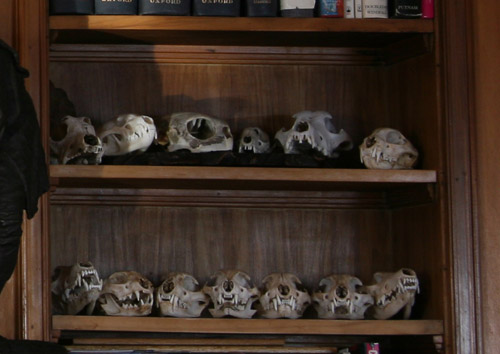
Do you cure them yourself?
Yes. I have several that are professionally cured that I am pretty sure originated at the San Diego Zoo, like the Bengal tiger skull. That was professionally cured. Many of them I find myself, in—obviously—different states of decomposition. Sometimes they’re already pretty well done. And then, sometimes I have to start from scratch, and that can be an ugly, smelly process. It’s sort of fallen down now, but we had a cage—an old chicken coop—that we would put the bones in and the little black beetles—the kind you see on roadkill—basically, they would just go to work. The cage keeps animals out.
Otherwise there’s so much you can’t do yourself, without really damaging the delicate parts—the eggshell bubble around the ear cavity, parts like that. They do a lot of the work, the beetles, but there’s also boiling and scrubbing and bleaching. I did go through a phase, when I was little, when I would put bones in my mother’s dishwasher. It didn’t really work that well, partly because they got too steamed; they got soft. The process was more damaging than helpful.
But boiling, boiling is great. You can boil a skull or some bones with a little bit of bleach and keep an eye on it, make sure you’re not going too far. Boiling works really well, but the beetles are the main thing. They do the very delicate work.
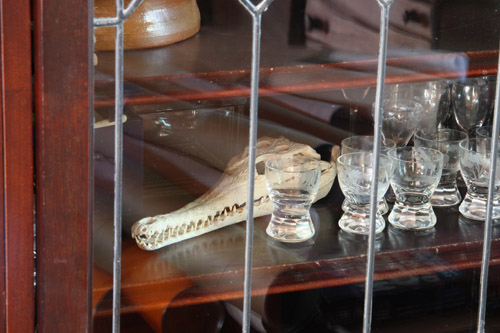
What’s the most important item in your collection?
I think of my collection in two parts: the things I find myself, or that friends have found, and then things that have been cured by professionals. The Bengal tiger is really gorgeous, so that’s definitely one of my favorites—but it came to me already cured. And that entire cat skeleton—a friend found it under a house. I have every single bone—the end of the toes, the tail, the entire thing. It died under a house and somehow it was protected from larger predators and it decomposed without being dragged around, which is the problem with most things when they’re decomposing, they’re also getting dragged around by a bunch of animals, torn apart. So it’s really hard to find something that’s actually whole. So the cat is very important, because it is whole.
Why collect stuff? How do you decide on, or give in to, the impulse to collect?
When I was really young—I must have been four or five—we were traveling across [the] country, and I found the hoof and part of the leg of a fawn. It must have been dried out enough that it wasn’t stinky, but I know it still had fur on it. I kept that thing forever. I loved it. I had a kind of fascination early on.
I have no idea where the impulse comes from. You could argue, I suppose, that it comes from food gathering—a basic impulse toward hoarding.
But I really think a lot of it is the desire to protect something, preserve it. When I look at that cat, for example, I think, “My god, if this cat gets shifted around too much, it’s not going to hang together. All these bones will be spread far and wide. It will not be a full cat.” Same thing with a lot of the bones: if this thing is not protected, it will not exist. So there’s some kind of sense inside me that the thing is worthwhile. For me, much of it is aesthetic. I just think they’re beautiful, so it’s love, too.
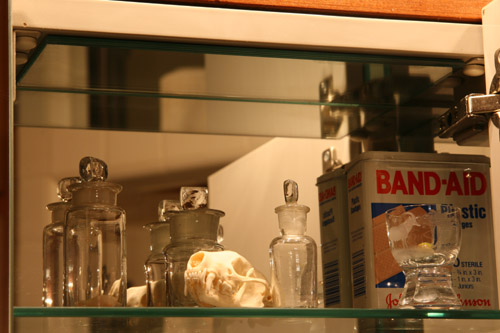
A sort of guardianship?
Yes. It’s impossible not to feel that. I can’t look at something like the skeleton of a cat and say no. I have lots of snake skeletons that are in different states of completion, and there’s no way I would leave something like that out in the hills. It wouldn’t be in my nature. I come from a collecting family as well. My father collected all sorts of things, some stuff that might be seen as useless and would not be protected in the general scheme of things.
My father was, for quite a while, the curator of the Museum of Comparative Zoology at Harvard. And when I was a kid, I used to go down the aisles of the basement there. They seemed very narrow and the shelves very tall. In any case, they were filled with jars of collections in formaldehyde. And that was his world, the world that he lived in, so that what I was doing didn’t seem in any way peculiar. In fact, when Harvard changed over to modern specimen jars, he kept some of the old handblown ones, and those are the jars I use now for some of the smaller bones. He also wrote articles about his research, and my mother drew the scientific drawings of fish skeletons for those articles.
I don’t suppose you’re ever going to be done with your collection?
No. There’s no reason to be done. If I lived in a tiny little apartment, I’d need storage space or something, but no, no, there is no outer limit. I think it will get harder and harder to stop.
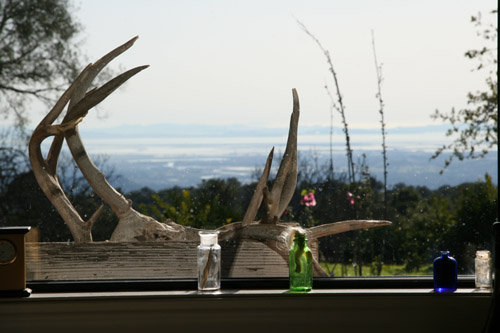
Poems are documents. Collections are documents. What does your collection document that your poetry doesn’t?
It’s hard for me to think about comparing the two. I guess they both preserve things. Poems preserve things in thought or image but not in reality. Maybe that gets back to the thing about wanting to protect and preserve; that impulse for preserving something in a poem might be in some ways similar to collecting. Protecting something you found in the woods is very much about that thing, though. So it’s very hard for me to actually make that comparison to poetry, where you are preserving a thought.
Do your friends and family understand your obsession, or do they give you grief?
No, they don’t give me grief. And nobody’s really given me a lot of grief about writing poetry either, so that’s pretty good, I guess.
I think they understand [that] my collecting is based on scientific curiosity. It’s incredible that you can take the tibia of a mouse and put it next to the tibia of a cow and they look almost exactly the same. Yet then I think, “Of course they look the same—why wouldn’t they? They serve the same purpose.” I think that my parents being who they were—my father being a naturalist, my mother really also being a naturalist, if not by profession then by training—probably made it a lot easier than it [otherwise] would have been for me to have this sort of collection as a kid. My mother, for example, drove that cat all the way from New Mexico to North Carolina for me. She put this thing in her trunk and drove it all the way. I consider that very understanding.
Sometimes I find [that] people react a little bit. The only reaction I find annoying is the assumption that it’s morbid—peculiar or exhibitionistic. Why would you do this morbid thing unless it was some kind of exhibition? But to me it’s not a morbid fascination at all; it’s a fascination with the beautiful. It’s about evolution; it’s about looking at evolution and how it happened—life. And [skeletons and bones] are gorgeous architectural and engineering feats.
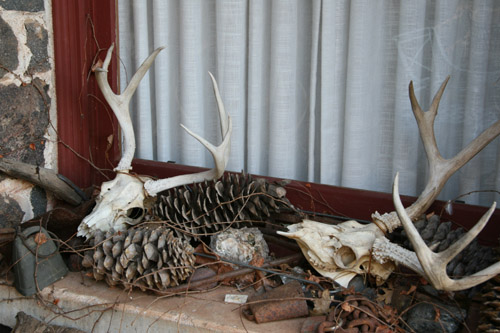
Is there a line you won’t cross, or have crossed—like going into debt or building an addition to your house—when it comes to collecting?
I’ve never killed anything for its bones, and I don’t think I ever would. I might kill a mouse to get it out of my house, but I wouldn’t kill it for its skeleton. That somehow goes against everything that it’s all about. It really is, in many ways, a life-affirming thing. There’s a store in New York that sells bones, and they actually raise things in some cases to kill and cure. I don’t like that. I wouldn’t buy things there.
And I’m not sure how I feel about human bones. I’ve never had an opportunity to collect anything that was human, particularly a skull. All considerations aside—in that it’s probably illegal to have them, and if you had one, where’d it come from, does it belong to a burial ground or a homeless person—all that aside, just the fact that something was human would make me feel somehow differently about it.
I’ve never dug up one of my dogs for the skull. I’ve thought about it, but I’ve never done that. It would be disruptive.
Photos by Jennifer Chandler
Richard Siken: What do you collect?
Jane Mead: Bones.
Can you describe some of them?
Most of the bones in my collection I have found; some of them have been presents. The one that looks the funniest was a present. It’s a manatee skull. It’s just a dodo of a skull, and a manatee is a dodo-looking animal. I love that. I have a Bengal tiger skull, lots of little tiny rodent bones, and skulls from owl kill—I have jars and jars of those. I have an entire cat skeleton, a whole jar of fish vertebra that are almost the same size—like poker chips—an alligator skull, a mountain lion skull, tens and tens of deer skulls, and several of the skulls from our horses. Not including the tiny ones, which would be hundreds, I have maybe 35 or 40 skulls. Some of them are hanging in the garage. The ones that are really beautiful and well cured are in the kitchen, or they’re on bookshelves. Some of them are just in boxes. I try to keep similar ones all together. I have a lot of coyote skulls and those are all together, though the lower jawbones are all mixed up. So some of them are really well taken care of and then some aren’t.

Do you cure them yourself?
Yes. I have several that are professionally cured that I am pretty sure originated at the San Diego Zoo, like the Bengal tiger skull. That was professionally cured. Many of them I find myself, in—obviously—different states of decomposition. Sometimes they’re already pretty well done. And then, sometimes I have to start from scratch, and that can be an ugly, smelly process. It’s sort of fallen down now, but we had a cage—an old chicken coop—that we would put the bones in and the little black beetles—the kind you see on roadkill—basically, they would just go to work. The cage keeps animals out.
Otherwise there’s so much you can’t do yourself, without really damaging the delicate parts—the eggshell bubble around the ear cavity, parts like that. They do a lot of the work, the beetles, but there’s also boiling and scrubbing and bleaching. I did go through a phase, when I was little, when I would put bones in my mother’s dishwasher. It didn’t really work that well, partly because they got too steamed; they got soft. The process was more damaging than helpful.
But boiling, boiling is great. You can boil a skull or some bones with a little bit of bleach and keep an eye on it, make sure you’re not going too far. Boiling works really well, but the beetles are the main thing. They do the very delicate work.

What’s the most important item in your collection?
I think of my collection in two parts: the things I find myself, or that friends have found, and then things that have been cured by professionals. The Bengal tiger is really gorgeous, so that’s definitely one of my favorites—but it came to me already cured. And that entire cat skeleton—a friend found it under a house. I have every single bone—the end of the toes, the tail, the entire thing. It died under a house and somehow it was protected from larger predators and it decomposed without being dragged around, which is the problem with most things when they’re decomposing, they’re also getting dragged around by a bunch of animals, torn apart. So it’s really hard to find something that’s actually whole. So the cat is very important, because it is whole.
Why collect stuff? How do you decide on, or give in to, the impulse to collect?
When I was really young—I must have been four or five—we were traveling across [the] country, and I found the hoof and part of the leg of a fawn. It must have been dried out enough that it wasn’t stinky, but I know it still had fur on it. I kept that thing forever. I loved it. I had a kind of fascination early on.
I have no idea where the impulse comes from. You could argue, I suppose, that it comes from food gathering—a basic impulse toward hoarding.
But I really think a lot of it is the desire to protect something, preserve it. When I look at that cat, for example, I think, “My god, if this cat gets shifted around too much, it’s not going to hang together. All these bones will be spread far and wide. It will not be a full cat.” Same thing with a lot of the bones: if this thing is not protected, it will not exist. So there’s some kind of sense inside me that the thing is worthwhile. For me, much of it is aesthetic. I just think they’re beautiful, so it’s love, too.

A sort of guardianship?
Yes. It’s impossible not to feel that. I can’t look at something like the skeleton of a cat and say no. I have lots of snake skeletons that are in different states of completion, and there’s no way I would leave something like that out in the hills. It wouldn’t be in my nature. I come from a collecting family as well. My father collected all sorts of things, some stuff that might be seen as useless and would not be protected in the general scheme of things.
My father was, for quite a while, the curator of the Museum of Comparative Zoology at Harvard. And when I was a kid, I used to go down the aisles of the basement there. They seemed very narrow and the shelves very tall. In any case, they were filled with jars of collections in formaldehyde. And that was his world, the world that he lived in, so that what I was doing didn’t seem in any way peculiar. In fact, when Harvard changed over to modern specimen jars, he kept some of the old handblown ones, and those are the jars I use now for some of the smaller bones. He also wrote articles about his research, and my mother drew the scientific drawings of fish skeletons for those articles.
I don’t suppose you’re ever going to be done with your collection?
No. There’s no reason to be done. If I lived in a tiny little apartment, I’d need storage space or something, but no, no, there is no outer limit. I think it will get harder and harder to stop.

Poems are documents. Collections are documents. What does your collection document that your poetry doesn’t?
It’s hard for me to think about comparing the two. I guess they both preserve things. Poems preserve things in thought or image but not in reality. Maybe that gets back to the thing about wanting to protect and preserve; that impulse for preserving something in a poem might be in some ways similar to collecting. Protecting something you found in the woods is very much about that thing, though. So it’s very hard for me to actually make that comparison to poetry, where you are preserving a thought.
Do your friends and family understand your obsession, or do they give you grief?
No, they don’t give me grief. And nobody’s really given me a lot of grief about writing poetry either, so that’s pretty good, I guess.
I think they understand [that] my collecting is based on scientific curiosity. It’s incredible that you can take the tibia of a mouse and put it next to the tibia of a cow and they look almost exactly the same. Yet then I think, “Of course they look the same—why wouldn’t they? They serve the same purpose.” I think that my parents being who they were—my father being a naturalist, my mother really also being a naturalist, if not by profession then by training—probably made it a lot easier than it [otherwise] would have been for me to have this sort of collection as a kid. My mother, for example, drove that cat all the way from New Mexico to North Carolina for me. She put this thing in her trunk and drove it all the way. I consider that very understanding.
Sometimes I find [that] people react a little bit. The only reaction I find annoying is the assumption that it’s morbid—peculiar or exhibitionistic. Why would you do this morbid thing unless it was some kind of exhibition? But to me it’s not a morbid fascination at all; it’s a fascination with the beautiful. It’s about evolution; it’s about looking at evolution and how it happened—life. And [skeletons and bones] are gorgeous architectural and engineering feats.

Is there a line you won’t cross, or have crossed—like going into debt or building an addition to your house—when it comes to collecting?
I’ve never killed anything for its bones, and I don’t think I ever would. I might kill a mouse to get it out of my house, but I wouldn’t kill it for its skeleton. That somehow goes against everything that it’s all about. It really is, in many ways, a life-affirming thing. There’s a store in New York that sells bones, and they actually raise things in some cases to kill and cure. I don’t like that. I wouldn’t buy things there.
And I’m not sure how I feel about human bones. I’ve never had an opportunity to collect anything that was human, particularly a skull. All considerations aside—in that it’s probably illegal to have them, and if you had one, where’d it come from, does it belong to a burial ground or a homeless person—all that aside, just the fact that something was human would make me feel somehow differently about it.
I’ve never dug up one of my dogs for the skull. I’ve thought about it, but I’ve never done that. It would be disruptive.
Photos by Jennifer Chandler
Richard Siken is a poet, painter, and filmmaker. His book Crush (Yale University Press, 2005) won the 2004 Yale Series of Younger Poets prize, a Lambda Literary Award, and a Thom Gunn Award. It was also a finalist for the National Book Critics Circle Award. His other books include War of the Foxes (Copper Canyon Press, 2015). Siken has received a Pushcart Prize, two Lannan residencies, two Arizona...


